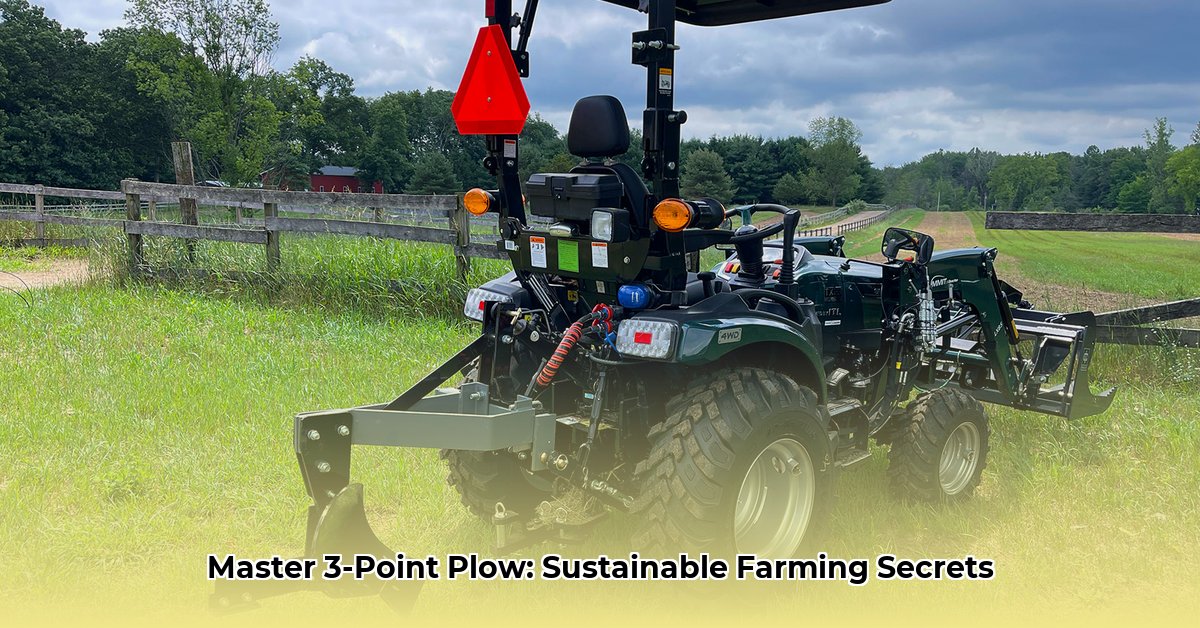
Understanding Your 3-Point Plow: A Foundation for Sustainable Tillage
Choosing the right equipment is paramount for efficient and sustainable farming. A 3-point plow, attached to your tractor's three-point hitch system, is a versatile tool for preparing your land. But selecting the correct plow and employing best practices are key to maximizing its benefits while minimizing its drawbacks. This guide provides a comprehensive overview, covering different types, setup, maintenance, and how to integrate its use into a sustainable farming strategy. For more information on three-point hitches, check out this helpful resource: Three-Point Hitch Info.
Do you know the implications of choosing the wrong type of plow for your soil type? Improper selection can lead to soil compaction and increased erosion, negating the environmental benefits of sustainable farming practices.
Types of 3-Point Plows
Several types of 3-point plows cater to different needs and soil conditions. Single-bottom plows are ideal for smaller farms or fields with obstacles, offering maneuverability and fuel efficiency. Conversely, multiple-bottom plows are suited for large-scale operations, increasing speed and coverage. The choice depends on factors like farm size, soil composition, and budget.
Selecting the Right Plow: A Crucial Decision
Before purchasing, consider several key factors. First, determine your soil type (clay, sandy loam, etc.), as this dictates the appropriate plow design and plowing depth. Second, assess your tractor's horsepower to ensure compatibility. A plow too large for your tractor can lead to damage or inefficient operation. Finally, define your budget, recognizing that prices vary based on features and construction quality. Choosing the right plow from the start significantly reduces future costs and inefficiencies.
Did you know that the incorrect plow choice can impact fuel consumption by up to 30%? Selecting a plow that matches your tractor's capacity and the specific needs of your soil ensures optimal performance and fuel efficiency.
Setting Up and Operating Your 3-Point Plow
Proper setup is crucial for safety and effective plowing. Always consult your manufacturer's instructions. Here is a step-by-step guide:
- Attachment: Securely connect the plow to your tractor's three-point hitch using the provided pins. Double-check all connections for strength and security.
- Depth Adjustment: Use the tractor's hydraulics to set the desired plowing depth. Begin with a shallow depth and gradually increase it as needed.
- Angle Adjustment: Fine-tune the plow's angle to achieve even furrows. This may involve some experimentation to optimize for your specific soil conditions.
- Operational Check: Observe the plow's performance. Uniform furrows indicate correct setup; uneven furrows necessitate adjustment.
Sustainable Farming with a 3-Point Plow: Optimizing Benefits, Minimizing Impacts
A 3-point plow offers several advantages for sustainable farming practices:
- Improved Soil Health: Proper plowing improves aeration and drainage, fostering healthy plant growth and reducing water runoff.
- Natural Weed Control: Plowing buries weed seeds and disrupts their lifecycle, reducing herbicide reliance.
- Enhanced Nutrient Cycling: It mixes organic matter into the soil, improving nutrient availability to plants.
- Cost Savings: Plowing is often a cost-effective land preparation method compared to other tillage techniques.
However, potential drawbacks exist:
- Soil Compaction: Over-plowing or improper practices can compact the soil, hindering root growth and water penetration.
- Erosion Risk: Plowed soil, especially on inclines, is more vulnerable to erosion, particularly when not paired with conservation practices.
- Fuel Consumption: While often more fuel-efficient than some other methods, plowing still consumes fuel.
Dr. Emily Carter, Professor of Soil Science at the University of Agriculture, emphasizes, "Sustainable tilling isn't just about the tool; it's about mindful practices. Consider factors like soil type, slope, and crop rotation to minimize environmental impact."
Maintenance and Sustainable Practices
Regular maintenance extends the plow’s life and ensures optimal performance. Regularly clean and lubricate the plow, inspecting it for wear after each use. Sharpen plowshares frequently to maintain effectiveness.
To further enhance sustainability:
- Contour Plowing: Plow along the contours of your land to minimize erosion.
- Strip Tillage: Plow only portions of the field, leaving strips undisturbed to reduce soil disturbance.
- Reduced Tillage: Minimize the number of times you plow each field.
Remember, integration with other sustainable practices, such as crop rotation and cover cropping, enhances long-term soil health and yields.
Choosing a Single-Moldboard Plow for Sustainable Agriculture
While various plow types exist, the single-moldboard plow remains a common choice. However, its impact on sustainability should be carefully evaluated. It offers thorough tillage and weed control, but also carries a higher risk of soil compaction and erosion compared to less intensive methods.
Soil Analysis: The Cornerstone of Sustainable Tillage
Understanding your soil is critical. Conduct a thorough soil test to analyze texture, structure, organic matter content, and drainage characteristics. This information directly impacts plow selection and tillage strategies. Adapting your practices to your soil's unique properties is a cornerstone of sustainable agriculture.
Alternatives to the Moldboard Plow
Chisel plows offer a less intensive alternative, fracturing compacted soil layers while minimizing inversion, thus promoting water infiltration and reducing erosion. The choice between a moldboard and chisel plow depends largely on your soil type and farming goals.
Choosing the right plow involves a careful evaluation of your soil, farming goals, and environmental considerations. Every decision should aim to find a balance between effective tillage and minimal soil disturbance—a principle paramount to sustainable agriculture.